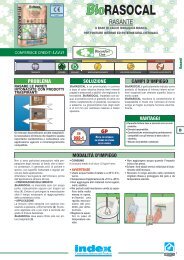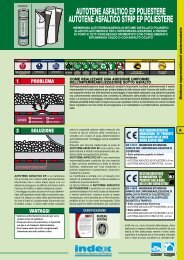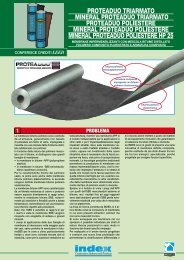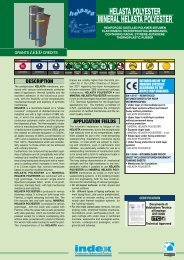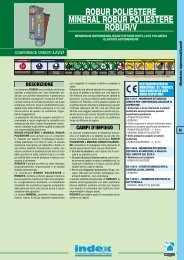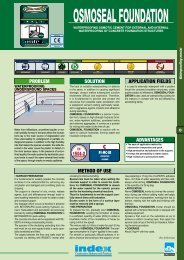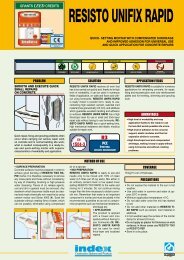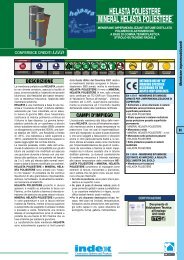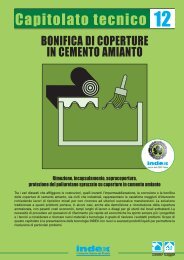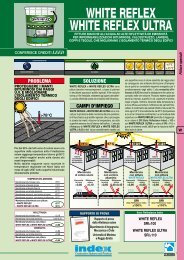Technical Specifications - Index S.p.A.
Technical Specifications - Index S.p.A.
Technical Specifications - Index S.p.A.
You also want an ePaper? Increase the reach of your titles
YUMPU automatically turns print PDFs into web optimized ePapers that Google loves.
Problems<br />
The waterproofing coverings of tunnels and underground<br />
works are usually subject to physical<br />
actions of impact: during the application phase<br />
as a result of site traffic, and subsequently due<br />
to the action of the material which will be placed<br />
over the waterproof layer. During its operational<br />
life, the waterproofing is mainly subject<br />
to static load and to the stress induced by the<br />
cracks that form in the laying surface due to the<br />
shrinkage of concrete and the effects of fatigue<br />
caused by the joining lines of prefabricated<br />
panels as a result of the vibration caused by the<br />
traffic of motor vehicles.<br />
During the earth covering operations, the covering<br />
is subject to abrasion and traction in<br />
case of vertical parts covered with drylined<br />
membranes.<br />
The waterproof coverings are chemically attacked<br />
by underground water, including the<br />
water polluted by humic acids, fertilisers and<br />
soil micro-organisms.<br />
The covering often serves functions other than<br />
that of a cover for the area beneath. One of<br />
these is that of being a parking facility (see<br />
<strong>Technical</strong> <strong>Specifications</strong> no. 8). It is usual to lay<br />
hot bituminous conglomerate or poured asphalt<br />
directly onto the waterproof covering, which<br />
must withstand the thermal shock deriving from<br />
applying the layers mentioned above.<br />
INTRODUCTION<br />
In this last case the covering will be exposed in<br />
winter to frost-defrost cycles and to the chemical<br />
attack of the saline solutions from the use<br />
of road salts.<br />
Finally, in case of a seismic event, the cover will<br />
be stressed by the differential movements of<br />
the layers of concrete in which it is inserted (see<br />
<strong>Technical</strong> <strong>Specifications</strong> no. 5 bis).<br />
Based on the stress to be incurred, the waterproof<br />
covering must be:<br />
• fully bonded to the works to be protected<br />
to minimise water seepage in the event of accidental<br />
perforation and to resist the parallel<br />
forces due to differential movements in the<br />
layers of concrete the covering is inserted<br />
into and the earth movements on the vertical<br />
walls.<br />
AREA TO BE<br />
TORCHED<br />
LAYING SURFACE<br />
• applied thickly: for total adherence the covering<br />
must be 4 mm thick to overcome the superficial<br />
roughness of the laying structure and<br />
such unavoidable problems as small stones<br />
and other granular materials which are always<br />
present in tunnel-like structures.<br />
• applied thickly: to withstand the abrasive action<br />
of the granules detached by friction from<br />
the cement surfaces upon which the covering<br />
was applied in case of SEISMIC event.<br />
• reinforced with elastic reinforcements featuring<br />
a high mechanical resistance to the<br />
fatigue from fissures opening and closing in<br />
the laying surface onto which the surface is<br />
bonded.<br />
• strengthened with reinforcing materials<br />
which give the best continuous strength,<br />
compatibly with the adhesion to the waterproofing<br />
mass, and in order to obtain a waterproofing<br />
layer featuring a uniform mechanical<br />
behaviour and puncture resistance in all<br />
thicknesses.<br />
• inherently puncture resistant. This must<br />
take place before the covering is protected by<br />
a successive layer and subject to accidental<br />
site dynamic punching that may cause leaks<br />
that are hard to identify.<br />
• resistant to chemical and biological agents<br />
present in the soil and in the other adjacent<br />
layers.<br />
• root resistant in all thicknesses, including<br />
the overlaps, in case the covering (see<br />
<strong>Technical</strong> <strong>Specifications</strong> no. 10) is in contact<br />
with the soil of a roof garden or where the<br />
works are to be covered with earth in which<br />
thick vegetation might subsequently grow.<br />
• applicable in single or multi-layered bondable<br />
sheets in a way that, when incorporating<br />
other functions in the covering (such as antipiercing<br />
function), the waterproofing element<br />
may always be reinforced.<br />
• Sufficient in its coefficient of friction with<br />
concrete, in seismic areas, to avoid excessive<br />
sliding between the works and waterproof<br />
cover (see <strong>Technical</strong> <strong>Specifications</strong> no.<br />
5 bis) in the foundations during high intensity<br />
shocks and to ensure stability during low intensity<br />
shocks.<br />
• In case of paved covers, resistant to the<br />
thermal shock and the hot punching due to<br />
laying operations and the rolling of the bituminous<br />
paving.<br />
2<br />
TUNNELS<br />
<strong>Technical</strong> <strong>Specifications</strong>



